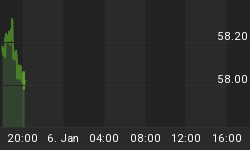
www.cartoonstock.com
First of all a Happy New Year, good luck and successful trading in 2011 to all of you.
Just recently Rennie Young from MarketTells (highly recommended, and hats off) presented a very interesting and telling study concerning the positive short-term (1-week time frame, spanning the first 5 sessions of the then following month) implications in the event the S&P 500 wrote better than a 5.0% monthly gain in the past, representing a significantly better than random chance for closing at a higher level five sessions later.
Due to the fact that the SPY (S&P 500 SPDR) gained +x.00% in December, and I received a couple of requests to show what regularly happened during the first 5 sessions of the year in the past, I checked for those occurrences where the SPY (S&P 500 SPDR) closed out a month with a better than +6.50% gain in the past.
Table I below shows all respective occurrences and the SPY (S&P 500 SPDR)'s historical performance (since 01/01/1990) over the course of the then following 1 to 5 sessions (and the minimum number of sessions - if any - until the index posted a first higher close above the trigger day's close), assumed one went long on close of the last session of a month where the SPY (S&P 500 SPDR) had closed out a month with a better than +6.50% monthly gain in the past.

(* no close below trigger day's close during period under review)
When the SPY (S&P 500 SPDR) closed out a month with a better than +6.50% monthly gain in the past, the SPY (S&P 500 SPDR)
- ... posted a 1.0%+ gain on 6 out of 19 occurrences, but never lost more than -0.60% on the first session of the then following month;
- ... posted at least one higher close above the trigger day's close over the course of the then following five sessions on all of the last 19 occurrences;
- ... never looked back and did not post a single close below the previous end-of-month close during the first five sessions of the then following month on 9 out of 19 occurrences;
- ... closed at a higher level five sessions later on 17 out of those 19 occurrences (or 89.47% of the time), with a median gain of +1.61% (in comparison to an at-any-time median weekly return of +0.31%) ; and
- ... was trading higher 1.0%+ 3 and 5 sessions later on 12 occurrences, but lower -1.0%+ on only 2 occurrences.
Despite the fact that the S&P 500 is up +0.07% on the last week of the year, up +6.53% on December, up 10.20% on the 4th quarter, up 22.02% on the last 6 months (semiannually) and up 12.78% on the year, the S&P 500 ended an otherwise positive year on a negative note, closing lower on the last two sessions of the year. Unfortunately (concerning it's statistically significance) the latter is quite a rare occurrence (2010 marks the 9th occurrence since 1900), but - from a historical point of view - shows some extraordinary bullish implications over the course of the first month of the then following year.
Table II below shows all occurrences and the S&P 500's historical performance (since 01/01/1930) over the course of the then following 2, 5 (1 week), 10 (2 weeks), 15 (3 weeks) and 21 (1 month) sessions (and the minimum number of sessions - if any - until the index posted a first higher close above the trigger day's close), assumed one went long on close of the last session of a year where the S&P 500 had closed lower on the last two sessions of the year in the past.

(* no close below trigger day's close during period under review)
When the S&P 500 had closed lower on the last two sessions of the year in the past, the S&P 500
- ... closed at a higher level 2 sessions, 2 weeks, 3 weeks as well as 1 month later on all of those 8 occurrences;
- ... posted a 1.0%+ gain 2 sessions, 2 weeks, 3 weeks and 1 month later on 4 up to all 8 occurrences (1 month later), but never closed lower less than -1.40% (not shown) below the previous end-of-year close on any of January's sessions (maximum drawdown);
- ... never looked back and did not post a single close below the previous end-of-year close during January on 4 out of 8 occurrences; and
- ... the setup's median weekly (5 sessions) and monthly (21 sessions) gain of +2.94% and +4.20% significantly surpasses the respective at-any-time weekly and monthly returns of +0.31% and 1.11%.
Conclusions
By closing out the month with a better than +6.5% gain, and ending the year on a negative note (two consecutive lower closes on the final two sessions of a year), and on top of other positive seasonalities like entering into the to 3rd year of the Presidential cycle (see The Third Year of the Presidential Cycle), probabilities and odds are tilt in favor of an at least short- and intermediate-term continuation of the recent uptrend in the markets.
Successful trading,
















